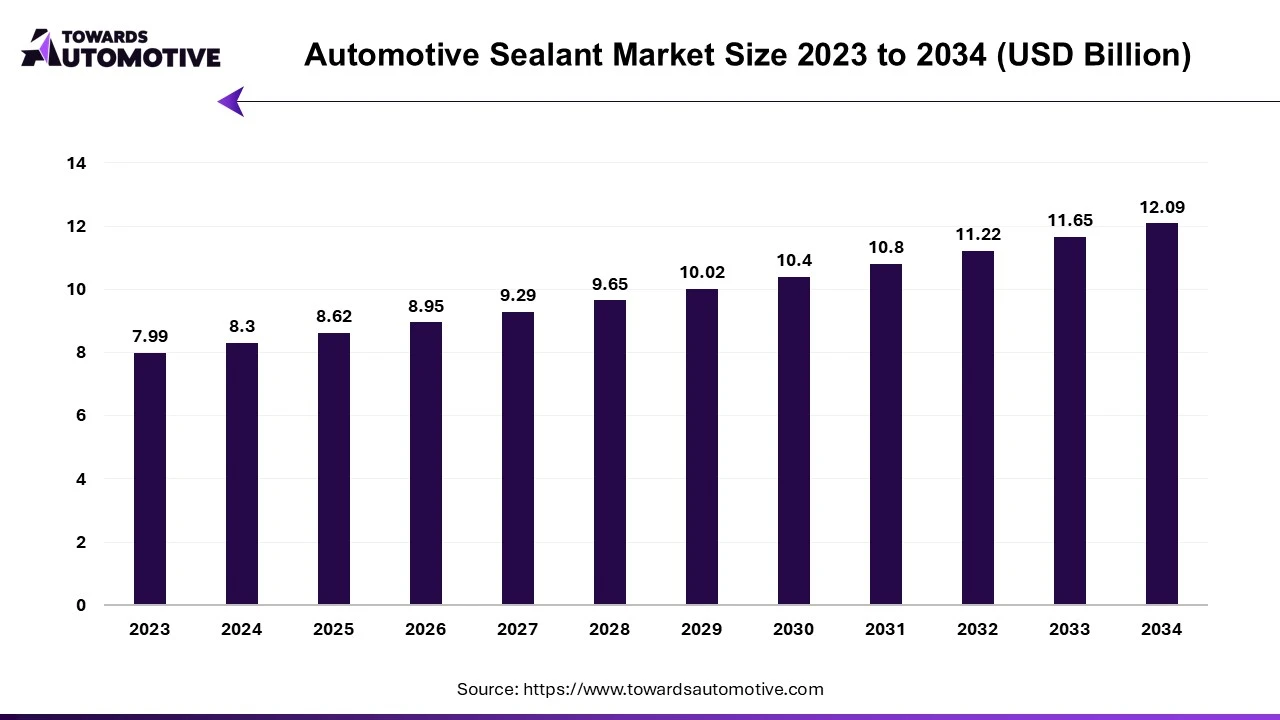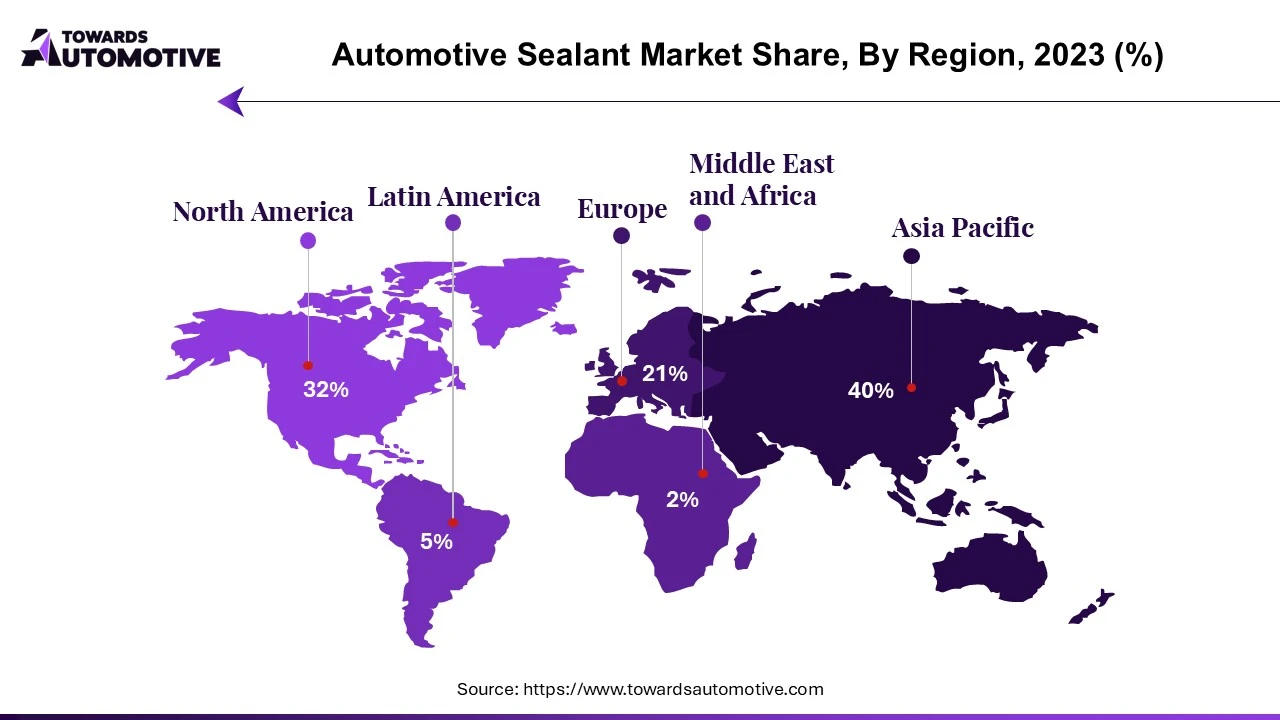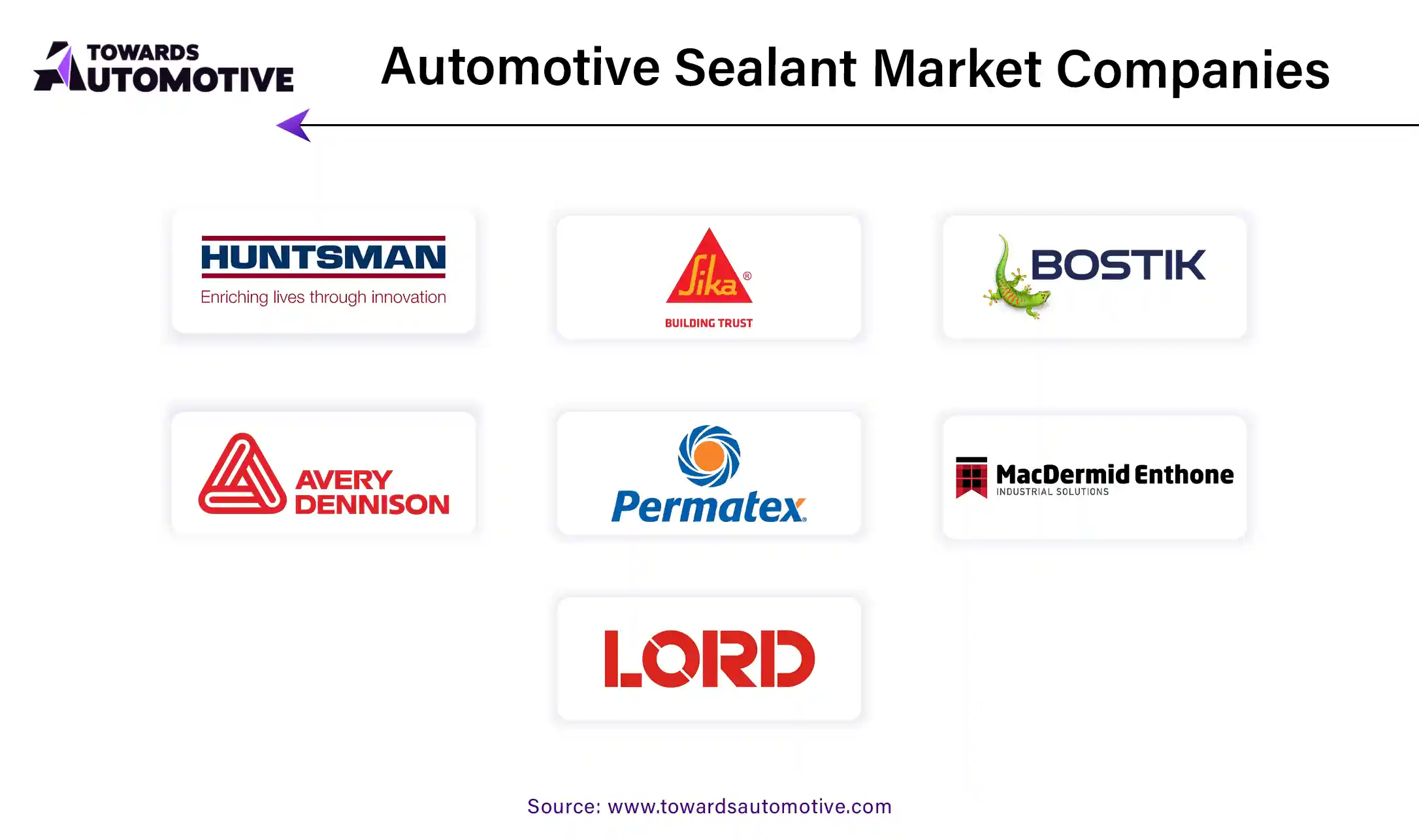April 2025
The automotive sealant market is forecasted to expand from USD 8.62 billion in 2025 to USD 12.09 billion by 2034, growing at a CAGR of 3.84% from 2025 to 2034.

Unlock Infinite Advantages: Subscribe to Annual Membership
The automotive sealant market plays a vital role in ensuring the structural integrity, durability, and performance of vehicles. Sealants are specialized materials used in automotive manufacturing to bond, seal, and protect various components, including body panels, windshields, and interior trims. These materials are designed to provide robust resistance to environmental factors such as moisture, heat, dust, and vibrations, thereby enhancing vehicle longevity and reliability. With the rapid growth of the automotive industry, the demand for advanced sealants has significantly increased, driven by their critical role in improving vehicle safety, comfort, and efficiency.
A notable trend in the market is the increasing adoption of lightweight and eco-friendly sealants, which align with the industry's push toward sustainability and fuel efficiency. As automakers focus on reducing vehicle weight to improve performance and meet stringent emission standards, lightweight sealants have emerged as a preferred solution. Additionally, the rise of electric and autonomous vehicles is further boosting the demand for innovative sealants capable of meeting the unique requirements of these advanced vehicles, such as thermal management and battery protection.
Technological advancements, including the development of high-performance and multi-functional sealants, are shaping the market landscape. These innovations cater to diverse applications across passenger and commercial vehicles, offering superior adhesion, durability, and resistance to harsh conditions. With increasing investments in automotive production and the growing emphasis on vehicle aesthetics and functionality, the automotive sealant market is poised for sustained growth. The market's expansion is also supported by evolving consumer preferences and regulatory standards, which continue to drive the adoption of advanced sealing technologies in the automotive sector.
AI plays a transformative role in the automotive sealant market by enhancing production processes, improving product performance, and streamlining operations. One of its key contributions lies in optimizing manufacturing processes. By integrating AI-driven automation and predictive analytics, manufacturers can achieve higher precision in sealant formulation and application. AI systems monitor production lines in real-time, identifying potential defects or inefficiencies and ensuring consistent product quality. This reduces material waste, lowers production costs, and improves overall efficiency.
AI also aids in the development of advanced sealants by analyzing vast datasets to identify new chemical compositions and performance-enhancing properties. Through machine learning algorithms, manufacturers can design sealants that offer better adhesion, durability, and resistance to extreme conditions, meeting the evolving demands of modern automotive designs, including electric and autonomous vehicles.
In addition, AI-powered tools are revolutionizing the application of sealants during vehicle assembly. Robotic systems guided by AI enable precise application of sealants, minimizing human error and ensuring consistent performance. These systems adapt to complex geometries and varying material requirements, particularly in lightweight and composite materials commonly used in modern vehicles.
Moreover, AI facilitates predictive maintenance and lifecycle management by analyzing data on sealant wear and performance under real-world conditions. This helps manufacturers offer enhanced aftersales services and ensures long-term reliability for automotive components. As sustainability becomes a focus, AI-driven innovations are also enabling the development of eco-friendly sealants with lower environmental impacts, supporting the industry's move toward greener practices. Thus, AI is driving efficiency, innovation, and sustainability across the automotive sealant market.
The rising sales of electric vehicles (EVs) are a major driver of growth in the automotive sealant market, as these vehicles require specialized sealing solutions to address their unique design and operational needs. Unlike internal combustion engine (ICE) vehicles, EVs incorporate high-voltage battery systems, electric drivetrains, and advanced electronics, all of which demand robust protection against external factors such as moisture, heat, and vibrations. Sealants play a critical role in safeguarding these sensitive components, ensuring their performance, safety, and longevity. The increasing production and adoption of EVs, spurred by government incentives, environmental concerns, and advancements in EV technology, are directly boosting the demand for high-performance sealants.
EV manufacturers also prioritize lightweight materials to enhance energy efficiency and maximize range, creating a need for advanced sealants that bond and seal composite materials effectively. Lightweight sealants help reduce vehicle weight while maintaining structural integrity, making them indispensable in EV design. Furthermore, thermal management is critical in EVs due to the high heat generated by battery systems. Sealants with superior thermal resistance and insulating properties are increasingly utilized to optimize battery performance and prevent overheating.
The growth of EVs has also led to the development of autonomous and connected vehicle technologies, requiring even more sophisticated sealing solutions for sensors, cameras, and other electronics. As the EV market continues to expand, sealant manufacturers are innovating to meet these evolving demands, focusing on eco-friendly formulations to align with the sustainable nature of EVs. The rapid growth in EV sales is therefore catalyzing advancements in the automotive sealant market, driving the adoption of innovative and specialized products tailored to this fast-growing segment.
The primary restraint of the automotive sealant market is the high cost of advanced sealants, which can deter adoption, particularly among small and medium-sized manufacturers. Additionally, the stringent environmental regulations governing the use of certain chemicals in sealants pose challenges for manufacturers, requiring significant investment in research to develop eco-friendly alternatives. Furthermore, the rising adoption of lightweight materials and evolving automotive designs demand continuous innovation, increasing production complexity and costs, which can limit market growth.
Advancements in nanotechnology are creating significant opportunities in the automotive sealant market by enabling the development of high-performance, multifunctional sealants. Nanotechnology allows manufacturers to enhance the properties of sealants by incorporating nanoscale additives, such as nanoparticles or nanofibers, which improve adhesion, durability, and resistance to extreme conditions. These innovations are particularly crucial in modern automotive designs, where sealants must perform under high-stress environments, such as intense heat, vibrations, and exposure to chemicals. Nanotechnology-based sealants offer superior thermal stability, water resistance, and UV protection, making them ideal for applications in electric vehicles (EVs), autonomous vehicles, and lightweight designs.
In EVs, nanotechnology sealants provide advanced thermal management, ensuring optimal performance and safety of battery systems by effectively dissipating heat and preventing overheating. Similarly, for lightweight vehicles, these sealants exhibit strong bonding capabilities for composite materials, reducing vehicle weight without compromising structural integrity. Nanotechnology also enables the development of eco-friendly sealants with lower volatile organic compound (VOC) emissions, aligning with stringent environmental regulations and the growing demand for sustainable solutions in the automotive sector.
Moreover, nanotechnology facilitates the creation of intelligent sealants with self-healing and anti-corrosion properties, enhancing vehicle durability and reducing maintenance costs. These smart sealants can repair micro-cracks or scratches autonomously, ensuring long-lasting performance in critical automotive components. As consumer preferences shift toward high-quality and sustainable vehicles, nanotechnology-driven innovations are positioning sealants as key enablers of cutting-edge automotive designs. With continuous research and development, nanotechnology holds immense potential to transform the automotive sealant market, creating opportunities for manufacturers to meet evolving industry demands and gain a competitive edge.
The silicon sealants segment held a dominant share of the market. The silicone sealant segment significantly drives the growth of the automotive sealant market, owing to its exceptional versatility, durability, and resistance to extreme conditions. Silicone sealants are widely used across various automotive applications, including sealing glass, metal, and plastic components, as well as providing waterproofing and insulation. Their ability to maintain flexibility and adhesion under extreme temperatures makes them particularly valuable for both internal and external vehicle components, ensuring reliable performance in diverse environmental conditions.
One of the key drivers for the silicone sealant segment is its application in electric vehicles (EVs). Silicone sealants offer excellent thermal and electrical insulation properties, making them ideal for protecting EV battery systems, electronic components, and charging ports. As the global adoption of EVs continues to rise, the demand for high-performance silicone sealants is also increasing. Additionally, their compatibility with lightweight and composite materials aligns perfectly with the automotive industry's shift toward fuel-efficient and energy-efficient vehicle designs.
Silicone sealants also play a critical role in enhancing vehicle safety and longevity by providing strong resistance to UV radiation, moisture, and chemicals. These properties make them indispensable for sealing windshields, sunroofs, and body joints, where exposure to harsh environmental conditions is frequent. Furthermore, advancements in silicone sealant formulations, such as improved curing times and eco-friendly compositions, are expanding their applications and driving adoption among automakers.
The segment's growth is further supported by the rising demand for premium and luxury vehicles, where silicone sealants are extensively used for superior noise, vibration, and harshness (NVH) reduction. With their exceptional performance and adaptability, silicone sealants are increasingly becoming a preferred choice in automotive manufacturing, propelling the overall growth of the automotive sealant market.
The passenger cars segment led the industry. The passenger car segment is a major driver of growth in the automotive sealant market, fueled by its dominance in global vehicle production and the rising demand for innovative car designs. Passenger cars extensively rely on sealants for critical functions such as bonding, sealing, and protecting various components, including windshields, body panels, and interior elements. These sealants not only enhance structural integrity but also improve vehicle safety, comfort, and performance, making them indispensable in car manufacturing. With increasing global production of passenger vehicles, especially in rapidly growing markets like Asia-Pacific, the demand for automotive sealants continues to expand.
The adoption of lightweight materials in passenger cars has further bolstered the growth of the automotive sealant market. Automakers are focusing on reducing vehicle weight to meet stringent fuel efficiency and emissions standards, and sealants are essential in bonding lightweight materials like aluminum and composites. These advanced sealants provide high-strength adhesion while maintaining flexibility, enabling manufacturers to achieve lightweight designs without compromising durability.
Additionally, the surge in electric and hybrid passenger vehicles is contributing significantly to the market’s expansion. These vehicles require specialized sealants for thermal management, battery protection, and sealing electronic components. With the global transition to sustainable mobility, the passenger car segment’s shift toward electric vehicles drives the need for innovative, high-performance sealants tailored to these requirements.
Moreover, consumer demand for premium and luxury passenger cars has created opportunities for advanced sealant applications. High-end vehicles often incorporate complex designs and materials that require specialized sealing technologies for noise reduction, vibration control, and aesthetic appeal. As automakers continue to innovate, the passenger car segment remains a critical growth engine for the automotive sealant market, driving advancements in sealant technology and adoption globally.

Asia Pacific dominated the automotive sealant market. The automotive sealant market in the Asia-Pacific (APAC) region is experiencing significant growth, driven by a combination of rising automotive production, economic development, and increasing consumer demand. APAC is the world’s largest automotive manufacturing hub, with countries like China, Japan, South Korea, and India leading vehicle production. The growing adoption of lightweight materials in vehicles, aimed at improving fuel efficiency and meeting stringent emission norms, has driven demand for high-performance automotive sealants. Sealants are essential for bonding and sealing lightweight components like aluminum and composites, contributing to enhanced vehicle efficiency and reduced weight.
Another growth factor is the rapid urbanization and economic development in emerging markets such as India and Southeast Asia. Rising disposable incomes and a growing middle class have led to increased demand for passenger vehicles, which directly translates to higher consumption of automotive sealants. Additionally, the booming electric vehicle (EV) market in the region is creating new opportunities for sealants. EVs require advanced sealing solutions for thermal management, electronic insulation, and battery protection. With governments across APAC pushing for EV adoption through incentives and infrastructure investments, the demand for sealants tailored to EV applications is on the rise.
Technological advancements in sealant formulations, including improved curing times and eco-friendly options, are further boosting adoption in APAC. The increasing focus on reducing noise, vibration, and harshness (NVH) in vehicles has also driven the use of sealants in enhancing passenger comfort and safety. Moreover, investments in local production facilities and supply chain improvements by global automotive sealant manufacturers are strengthening the market’s foundation in the region. These factors collectively position APAC as a key growth region for the automotive sealant market, underpinned by its dynamic automotive industry and evolving consumer preferences.
North America is expected to grow with the highest CAGR during the forecast period. The automotive sealant market in North America is experiencing robust growth, driven by advancements in vehicle manufacturing, a focus on sustainability, and increasing adoption of electric vehicles (EVs). North America, particularly the United States and Canada, is home to some of the largest automakers and suppliers in the world. These manufacturers are increasingly incorporating advanced sealant technologies to meet stringent fuel efficiency and emission standards, which is fueling market expansion. Sealants are crucial for bonding lightweight materials such as aluminum and composites, enabling automakers to produce fuel-efficient vehicles while maintaining durability and safety.
The growing demand for electric vehicles in the region is a significant driver of the automotive sealant market. EVs require specialized sealants for applications such as battery sealing, thermal management, and electronic insulation. With government policies and incentives encouraging EV adoption, alongside the expansion of EV charging infrastructure, the need for high-performance automotive sealants is increasing. The transition to EVs is also prompting innovation in sealant formulations, such as those designed for heat resistance and long-term durability.
Moreover, North America's emphasis on vehicle safety and comfort has driven demand for sealants that enhance noise, vibration, and harshness (NVH) reduction. Consumers in the region increasingly prefer vehicles with improved passenger comfort, pushing automakers to adopt advanced sealing solutions. Additionally, the rise of luxury and premium vehicle segments in North America has further bolstered the demand for high-quality sealants, as these vehicles require specialized materials for aesthetics, durability, and performance.
Technological innovations in eco-friendly and low-VOC (volatile organic compound) sealants are another growth factor, aligning with regional environmental regulations and sustainability goals. These factors, combined with a robust automotive manufacturing ecosystem and rising consumer expectations, are propelling the growth of the automotive sealant market in North America.

By Vehicle Type
By Sealant Type
By Application
By Curing Mechanism
By Region
April 2025
April 2025
April 2025
April 2025
We offer automotive expertise for market projections and customizable research, adaptable to diverse strategic approaches.
Contact Us